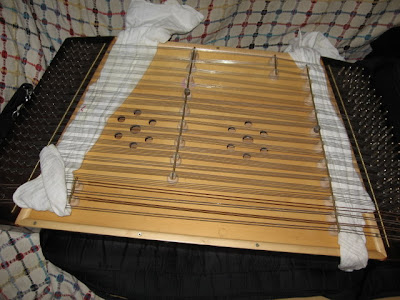|
|
Post by Dick Glasgow on Jun 23, 2007 8:44:35 GMT 1
|
|
|
|
Post by sarahpercs on Mar 22, 2008 0:39:42 GMT 1
I'm having "experience" of the Tambal Mic right now!!
Having to learn how to play one for a stop-gap before getting access to a full concert Cimbalom next week.
It's not easy as the tuning is completely different from the Cimbalom.
I think the Cimbalom tuning actually makes more sense than the Tambal Mic! Never thought I would ever admit another instrument was more complicated than the Cimbalom!
I have a couple of pics that I will try to put on here tomorrow.
|
|
gadulka
Dulci-Psaltery (0 - 10 Posts)

Posts: 4
|
Post by gadulka on Mar 26, 2008 13:47:28 GMT 1
Ah, the Hora small cimbalom (þambal mic) is born with a lot of problems, some of which can be fixed. The end result of tinkering with it is a compromise that plays, but isn't a great instrument. it is, however, what most Romanian Gypsy musicians use by default, and it will suffice if you are using it to back up klezmer or Romanian music wthout expecting it to play the full role of a melodic cimbalom or good tsimbl.
The Hora instruments are shipped without setup - you will have to find the correct spacing for the bridges, and the bass strings are simply not functional until you have them replaced. The scale of the instrument is just short of what you need for acoustic functionality at the high notes, so you have to cut extra bridge inserts (brass tubing or - in my case - cheap and easy #2 pencil cut to size) to shorten certain string courses in the upper registers.
The very highest string courses simply can not be tuned adequately, so everybody just forgets about playing above the high F# or G above the left melody D. I had Akos Nagy in Budapest put decent brass wound bass strings on mine, but he was so appalled at the Hora instrument he only did it as a favor to me. Akos doesn't like working on anything that is not acoustically perfect.
The end result plays OK for Romanian lautar accompaniment patterns (þiturii) and for learning and playing basic klezmer. That is, it is essentially a percussion instrument in a string band outdoors. Pete Rushevsky strings his Hora with soft phosphor bronze strings, which sound nice but break easily and can't stand the strong whacking that playing Romanian patterns requires. We all tune ours in a modified Hungarian tuning.
Still, if you are looking to learn small cimbalom for, it beats a US or English hammered dulcimer, and it is cheap enough to be semi-disposable.
|
|
|
|
Post by Dick Glasgow on Mar 26, 2008 13:55:39 GMT 1
Fascinating stuff gadulka. You must have amazing patience to work away with such an instrument & all it's faults. I must say, I'd never thought of the idea of a Disposable Dulcimer before!   Cheers Dick |
|
gadulka
Dulci-Psaltery (0 - 10 Posts)

Posts: 4
|
Post by gadulka on Apr 1, 2008 13:19:33 GMT 1
Well, I am not sure what the Hora tsambal mic goes for these days... but if you happen to be traveling through Reghin in Mures County, Romania, the Hora factory shop is in the downtown, offering all kinds of cheap violins and guitars (especially their unplayable cobzas.) I bought mine at the factory shop for EU 150 five years ago. It might be up to EU 250 these days, I am not sure.
The problem with hora is that they are the old Communist era State Instrument building factory. When communism ended, one shop manager privatized part of the violin shop into the Glika Violin factory, now located out on the edge of Reghin, taking all the good instrument makers with him. The remainder work at Hora.
Hora builds instruments on a four month schedule - four months of building violins, then the same crew build guitars for four months,then perhaps basses, then perhaps the oddball folky stuff like cimbaloms and cobzas. When these sell out, one has to wait until the next four month factory cycle for that instrument. For one thing, nobody can develope any expert luthier skills this way. And another is hat you are never sure whether or not the crew that worked on your instrument has ever tried to build one before.
In my case, I got lucky. My tsambal holds its tuning and can actually be used in concert. I have a full size cimbalom in my band, but sometimes we have to travel to places (Portugal for example) where we can not borrow a full size cimbalom, and we are not able to fly our gigantic old Bohack with us. Solution? Wrap the 145 EU tsambal in a blanket, stuff it in its handy carrying case (the size of an art student's portfolio) and take it on the plane. If the baggage handlers kill it, well, it is only EU 145, right? And it isn't dead yet. My cimbalom player complains (its rather like forcing a great guitar player to do a concert on a crap mandolin) but we get to do the gig.
|
|
gadulka
Dulci-Psaltery (0 - 10 Posts)

Posts: 4
|
Post by gadulka on Apr 1, 2008 14:03:45 GMT 1
Pete Rushevsky's modified Hora tsimbl. Not the brass rods staggered as bridge posts in the high register. Three courses (I prefer the 4-5 course) brass phosphor strings (a bit to soft for me.) Bass strings are unwound phosfor brass (and virtually unplayable)  My Hora - you can't really see the bridge modifications. The cloth is there to damp the strings. Bass are brass wound replacements from the factory strings.  |
|